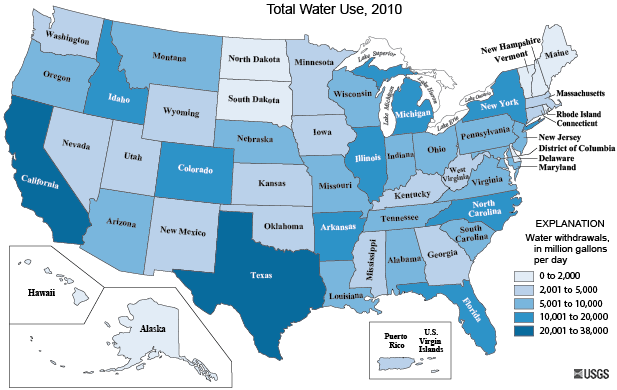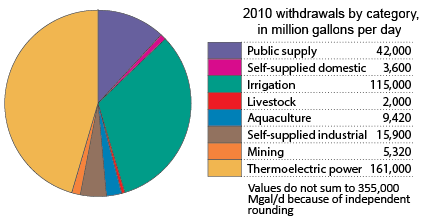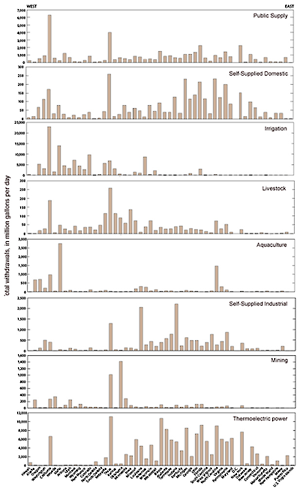Total Water Use
The USGS has estimated water use for the United States every 5 years since 1950. Estimates are provided for groundwater and surface-water sources, for fresh and saline water quality, and by sector or category of use. Estimates have been made at the State level since 1950, and at the county level since 1985. Water-use estimates by watershed were made from 1950 through 1995, first at the water-resources region level (HUC2), and later at the hydrologic cataloging unit level (HUC8).
2010 Water Use
(source: Maupin, M.A., Kenny, J.F., Hutson, S.S., Lovelace, J.K., Barber, N.L., and Linsey, K.S., 2014, Estimated use of water in the United States in 2010: U.S. Geological Survey Circular 1405, 56 p., https://pubs.usgs.gov/circ/1405/.)
Total freshwater and saline-water withdrawals for 2010 were estimated to be 355,000 million gallons per day (Mgal/d; equivalent to 355 billion gallons per day), or 397,000 thousand acre-feet per year (acre-ft/yr). Freshwater withdrawals made up 86 percent of the total, and saline-water withdrawals made up the remaining 14 percent. Most saline-water withdrawals were seawater and brackish coastal water used for thermoelectric power.

As in 2005, water withdrawals in four States—California, Texas, Idaho, and Florida—accounted for more than one-quarter of all fresh and saline water withdrawn in the United States in 2010. California accounted for 11 percent of the total withdrawals for all categories and 10 percent of total freshwater withdrawals for all categories nationwide.
| State | Percentage of total withdrawals | Cumulative percentage of total withdrawals |
|---|---|---|
| California | 11% | 11% |
| Texas | 7% | 18% |
| Idaho | 5% | 23% |
| Florida | 4% | 27% |
| Illinois | 4% | 30% |

The three largest categories were thermoelectric power, irrigation, and public supply, cumulatively accounting for 90 percent of the national total.
In these bar graphs the States are ordered geographically from west to east. (Click the image for a larger view.) The magnitude of the withdrawals cannot be compared here as the scales of the graphs are not the same, but the different geographic distributions of categories of water use can be examined.
Irrigation withdrawals are predominantly in Western States to the left of the graphs. Thermoelectric power is larger in the Midwest and Eastern States.
Higher withdrawals for California (fifth bar from the left) are apparent on the public supply, domestic, irrigation, livestock, aquaculture and thermoelectric power graphs. Texas, another State with large withdrawals in a number of categories, is to the left of center and is prominent on the public supply, self-supplied domestic, livestock, self-supplied industrial, mining, and thermoelectric power graphs.
https://water.usgs.gov/watuse/50years.html
Domestic water use includes indoor and outdoor uses at residences, and includes uses such as drinking, food preparation, bathing, washing clothes and dishes, flushing toilets, watering lawns and gardens, and maintaining pools. Domestic water use includes potable and non-potable water provided to households by a public water supplier (domestic deliveries) and self-supplied water use. Self-supplied domestic water use is typically withdrawn from a private source, such as a well, or captured as rainwater in a cistern.
https://www3.epa.gov/watersense/kids/index.html
Selected Water-Use Bibliography for the United States - State and Regional Reports
MARYLAND
Maryland Water Resources Administration, 1984, Charles County area water supply resources development and management plan: Maryland Department of Natural Resources, 282 p.
Maryland Water Resources Administration, 1987, Maryland water withdrawal and use report for 1985: Maryland Department of Natural Resources, 40 p.
Wheeler, J.C., 1990, Water withdrawal and use in Maryland, 1986: U.S. Geological Survey Open-File Report 88-714, 30 p.
Wheeler, J.C., 1990, Maryland and the District of Columbia water supply and use in National Water Summary 1987-Hydrologic events and water supply and use: U.S. Geological Survey Water-Supply Paper 2350, p. 291-298.
Wheeler, J.C., 1991a, Water withdrawal and use in Maryland, 1987: U.S. Geological Survey Open-File Report 90-572, 28 p.
Wheeler, J.C., 1991b, Water withdrawal and use in Maryland, 1992-93, U.S.Geological Survey Water Resources Investigations 96-4314, 42 p.
Wheeler, J.C., 1992, Water use in Maryland, 1988-89: U.S. Geological Survey Water-Resources Investigations Report 91-4179, 33 p.
Wheeler, J.C., 1995, Water withdrawal and use in Maryland, 1990-91: U.S. Geological Survey Water Resources Investigations 93-4225, 42 p.
Wheeler, J.C., 1998, Freshwater use in Maryland, 1995: U.S. Geological Survey Fact Sheet FS 115-98, 2p.
Wheeler, J.C., and Wilde, F.D., 1989, Ground-water use in the Coastal Plain of Maryland, 1900-1980: U.S. Geological Survey Open-File Report 87-540, 173 p.
The average American family of four uses 400 gallons of water per day. On average, approximately 70 percent of that water is used indoors, with the bathroom being the largest consumer (a toilet alone can use 27 percent!).
Indoor Water Guzzlers and Tips to Fix!
Standard toilets use 1.6 gallons per flush, while older toilets can use as much as 3.5 to 7 gallons per flush.
- TIP: Replace older models with a WaterSense labeled toilet. They use 1.28 gallons per flush or less, are certified to be high performing, and can reduce the amount of water a family uses for toilets by 20 to 60 percent.
- TIP: Be sure to check for leaks! A running toilet can waste about 200 gallons every day.
Standard showerheads use 2.5 gallons per minute and also require energy to heat the water.
- TIP: Shower Better by replacing showerheads with WaterSense labeled models; replacing just one showerhead can save the average family 2,900 gallons of water, the amount of electricity needed to power its home for 13 days, and more than $70 in utility bills. WaterSense labeled models are certified to be high performing, available in many styles and price points, and some utilities even offer rebates.
A bathroom faucet generally runs at 2 gallons per minute.
- TIP: Turn off the tap while brushing your teeth or shaving; that alone can save a person more than 200 gallons of water per month.
- TIP: Replace faucets and aerators with WaterSense labeled models to save even more.
Outside the bathroom, there are many opportunities to save water. Here are some common water efficiency measures, along with a few solutions to those problems you may not have known existed:
- High–efficiency washing machines can conserve large amounts of water. Traditional models use between 27 and 54 gallons of water per load, but new, energy—and water—conserving models (front–loading or top–loading, non-agitator ones) use less than 27 gallons per load.
- Washing the dishes with an open tap can use up to 20 gallons of water, but filling the sink or a bowl and closing the tap saves 10 of those gallons.
- Keeping a pitcher of water in the refrigerator saves time and water instead of running the tap until it gets cold.
- Not rinsing dishes prior to loading the dishwasher could save up to 10 gallons per load.
- Still looking for more tips? We have more on how to save indoors AND outdoors here.
WaterSense, a partnership program sponsored by the U.S. Environmental Protection Agency, seeks to help families and businesses realize that they can reduce water use by 20 to 30 percent by doing just a few simple things, such as upgrading to higher quality, more efficient products. For more information, visit the WaterSense website.
Alice in Waterland activity
http://iowaee.org/wp-content/uploads/2016/11/AliceInWaterland-Final_29Nov2016.pdf
It is always important to try to use water more efficiently. But there are times when it becomes even more important, such as when drought occurs. Drought happens somewhere in the U.S. every year. In 2015, California is facing one of its most severe droughts on record and, in September 2012, 65 percent of the country was in drought. Drought is sometimes called the slow motion natural disaster. Economic losses due to drought in 2012 were in the billions and many communities struggled to provide important water services.
The Drought Monitor provides weekly updates of the status of drought in the U.S.
During a drought, your water utility may ask you to limit your outdoor watering or impose other restrictions. But all members of a community can step up their savings to ensure that water is available to meet critical needs. Here are some tips to keep in mind.
- Follow the rules
Your water utility must ensure water is available to fight fires and meet other critical needs, so help your community by following the rules. They will be lifted when water shortages end. - Look for leaks
The last thing you want to do during a drought is waste water through leaks. Look for leaks indoors and out, and if you find them, fix them. - Consider an upgrade
If you have been thinking about a bathroom makeover, a drought is a great time to get busy. You will help your utility with immediate savings and save yourself money on future bills. WaterSense labeled products are a great way to save! - Take a sprinkler break
Outdoor water use can put a lot of stress on local water supplies. You can be water-smart by letting your grass grow longer and making other maintenance adjustments. Grass doesn’t need to be green year round—you can cut back on watering and the green will return when rains return. WaterSense has lots of water–saving tips for drought resilient landscapes. If you’re interested in some quick-fix tips for the summer months, see our When It’s Hot page. - Go the extra mile
If you want to go above and beyond in water savings, think about reusing water. You can collect water in a bucket while waiting for the shower to warm up or when washing pots, and use it to water container plants or flower beds. Use your imagination to come up with creative ways to save water or see more WaterSense tips on our start saving page.
Fix a Leak Week is celebrated in March of each year as a time to remind Americans to check their household fixtures and irrigation systems for leaks.
The Facts on Leaks:
- The average household's leaks can account for more than 10,000 gallons of water wasted every year, or the amount of water needed to wash 270 loads of laundry.
- Household leaks can waste more than 1 trillion gallons annually nationwide. That's equal to the annual household water use of more than 11 million homes.
- Ten percent of homes have leaks that waste 90 gallons or more per day.
- Common types of leaks found in the home include worn toilet flappers, dripping faucets, and other leaking valves. All are easily correctable.
- Fixing easily corrected household water leaks can save homeowners about 10 percent on their water bills.
- Keep your home leak-free by repairing dripping faucets, toilet flappers, and showerheads. In most cases, fixture replacement parts don't require a major investment.
- Most common leaks can be eliminated after retrofitting a household with new WaterSense labeled fixtures and other high-efficiency appliances.
Leak Detection:
- A good method to check for leaks is to examine your winter water usage. It's likely that a family of four has a serious leak problem if its winter water use exceeds 12,000 gallons per month.
- Check your water meter before and after a two-hour period when no water is being used. If the meter does not read exactly the same, you probably have a leak.
- One way to find out if you have a toilet leak is to place a drop of food coloring in the toilet tank. If the color shows up in the bowl within 10 minutes without flushing, you have a leak. Make sure to flush immediately after this experiment to avoid staining the tank.
Faucets and Showerheads:
- A leaky faucet that drips at the rate of one drip per second can waste more than 3,000 gallons per year. That's the amount of water needed to take more than 180 showers!
- Leaky faucets can be fixed by checking faucet washers and gaskets for wear and replacing them if necessary. If you are replacing a faucet, look for the WaterSense label.
- A showerhead leaking at 10 drips per minute wastes more than 500 gallons per year. That's the amount of water it takes to wash 60 loads of dishes in your dishwasher.
- Most leaky showerheads can be fixed by ensuring a tight connection using pipe tape and a wrench. If you are replacing a showerhead, look for one that has earned the WaterSense label.
Toilets:
- If your toilet is leaking, the cause is often an old, faulty toilet flapper. Over time, this inexpensive rubber part decays, or minerals build up on it. It's usually best to replace the whole rubber flapper—a relatively easy, inexpensive do-it-yourself project that pays for itself in no time.
- If you do need to replace the entire toilet, look for a WaterSense labeled model. If the average family replaces its older, inefficient toilets with new WaterSense labeled ones, it could save 13,000 gallons per year. Retrofitting the house could save the family nearly $2,400 in water and wastewater bills over the lifetime of the toilets.
Outdoors:
- An irrigation system should be checked each spring before use to make sure it was not damaged by frost or freezing.
- An irrigation system that has a leak 1/32nd of an inch in diameter (about the thickness of a dime) can waste about 6,300 gallons of water per month.
- To ensure that your in-ground irrigation system is not leaking water, consult with a WaterSense irrigation partner who has passed a certification program focused on water efficiency; look for a WaterSense irrigation partner.
- Check your garden hose for leaks at its connection to the spigot. If it leaks while you run your hose, replace the nylon or rubber hose washer and ensure a tight connection to the spigot using pipe tape and a wrench.


No comments:
Post a Comment